![]()
HISTORY OF BINGHAM
Imports from the Continent
Please click an area on the map:
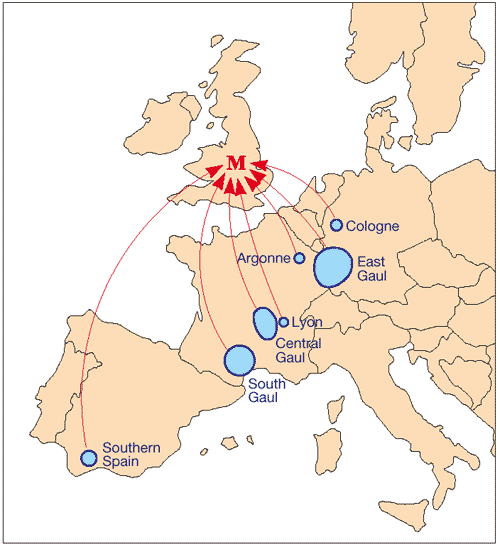
Argonne
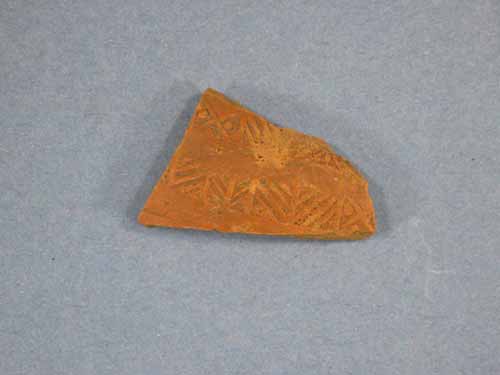
Argonne red ware imported from near
Rheims in the late 3rd to mid 4th century. This sherd comes from a bowl decorated
with a distinctive roller stamped geometric patterns. The roller would have
been engraved to make a pattern and used on leather-soft clay before firing.
Nottingham University Museum Photo: Robin Aldworth
Central Gaul
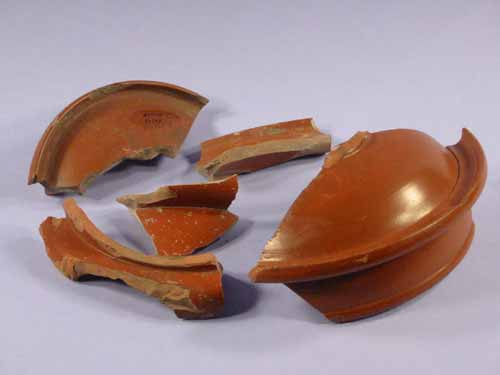
These shiny red bowls are imported from
Gaul. This type of bowl with the flange was common in the 2nd century AD. It
is not certain which part of Gaul these came from.
Nottingham University Museum Photo: Robin Aldworth
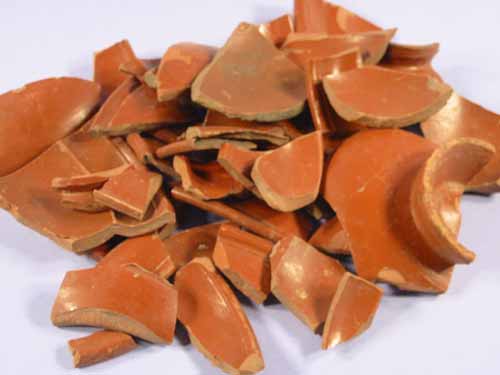
A great number of fine red ware (samian)
bowls, dishes, jars and specialised inkpots were imported from Gaul to Margidunum.
They were made in all parts of Gaul at different times. This type of pottery
is common on military sites in Britain, less common on farmsteads or village
sites.
Nottingham University Museum Photo: Robin Aldworth
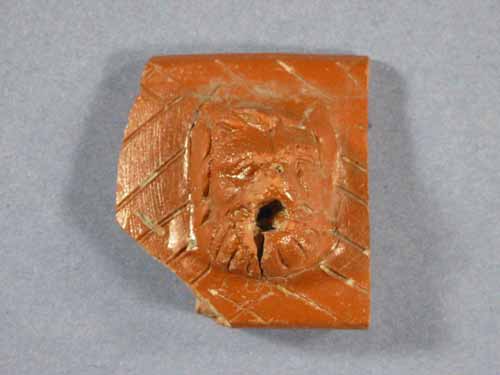
Fine red slipped samian ware mortarium,
a kind of mixing bowl used to pulp and mash fruit and vegetables. This example
comes from Central or East Gaul. The potter has made a spout in the shape of
a lion’s head to pour off the liquid.
Nottingham University Museum Photo: Robin Aldworth
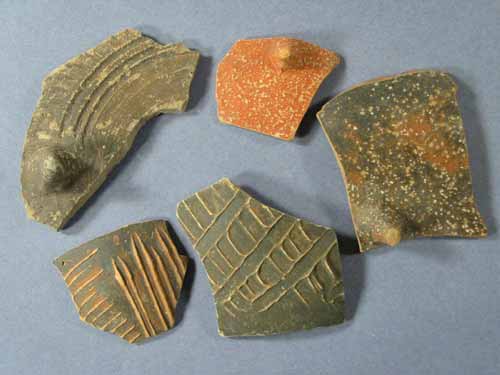
These sherds are from fine vessels imported
from Central Gaul round Lezoux and Martres-de-Veyres in the 1st and early 2nd
centuries. The sherds come from elaborate beakers which have semi-liquid clay
trailed over to form surface patterns, a bit like decorative icing, before being
dipped in liquid clay, called a slip, which fires to a darker colour, brown
or orange. The examples to the right have a rough coating of dried clay particles,
called rough casting, scattered over their surfaces before being dipped in the
coloured slip to create a different effect. The sherds at the top come from
shallow bowls with three little feet, called tripod dishes.
Nottingham University Museum Photo: Robin Aldworth
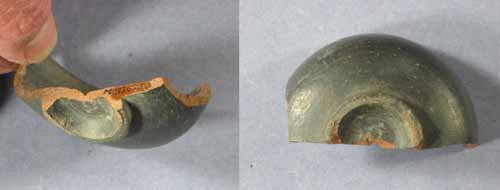
This very fine black small bowl or cup
comes from the Central Gaulish workshops around Lezoux, also making the more
popular red samian ware. Some of the black slip beakers from Margidunum may
also have come from here as well as other kilns around Trier in East Gaul.
Nottingham University Museum Photo: Robin Aldworth
East Gaul

These shiny red bowls are imported from
Gaul. This type of bowl with the flange was common in the 2nd century AD. It
is not certain which part of Gaul these came from.
Nottingham University Museum Photo: Robin Aldworth

A great number of fine red ware (samian)
bowls, dishes, jars and specialised inkpots were imported from Gaul to Margidunum.
They were made in all parts of Gaul at different times. This type of pottery
is common on military sites in Britain, less common on farmsteads or village
sites.
Nottingham University Museum Photo: Robin Aldworth

Fine red slipped samian ware mortarium,
a kind of mixing bowl used to pulp and mash fruit and vegetables. This example
comes from Central or East Gaul. The potter has made a spout in the shape of
a lion’s head to pour off the liquid.
Nottingham University Museum Photo: Robin Aldworth
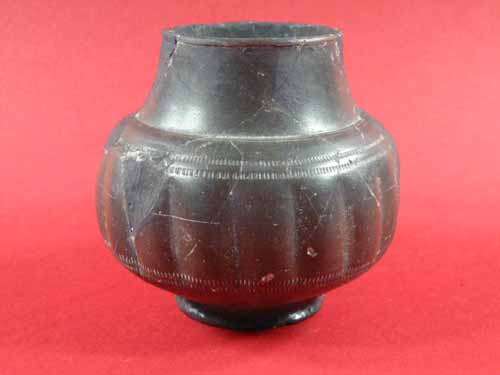
This is a lovely beaker with a shiny
greenish black coating. It was made in Trier, East Gaul, and imported to Margidunum
in the late 2nd or mid 3rd century AD. Some examples have motto written in white
around the body of the unindented beaker such as “Bibe me” Drink
me or “DA MERVM” Give me unwatered wine!
Nottingham University Museum Photo: Robin Aldworth
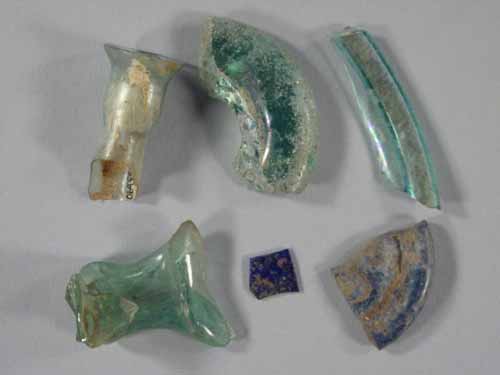
These glass fragments are from delicate
phials, cups and beakers, probably imported from the Rhineland (East Gaul) or
made from imported recycled glass from the Continent.
Nottingham University Museum Photo: Robin Aldworth
South Gaul

These shiny red bowls are imported from
Gaul. This type of bowl with the flange was common in the 2nd century AD. It
is not certain which part of Gaul these came from.
Nottingham University Museum Photo: Robin Aldworth

A great number of fine red ware (samian)
bowls, dishes, jars and specialised inkpots were imported from Gaul to Margidunum.
They were made in all parts of Gaul at different times. This type of pottery
is common on military sites in Britain, less common on farmsteads or village
sites.
Nottingham University Museum Photo: Robin Aldworth
Spain
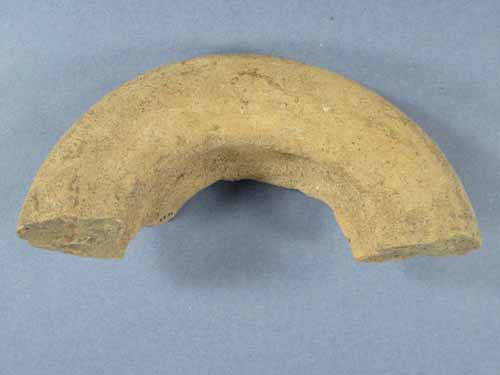
This fragment of pottery is part of
the rim of an amphora, a huge wine jar, from southern Spain. These are very
common in Britain from the 1st to 3rd centuries but are not very common at Margidunum.
Nottingham University Museum Photo: Robin Aldworth
